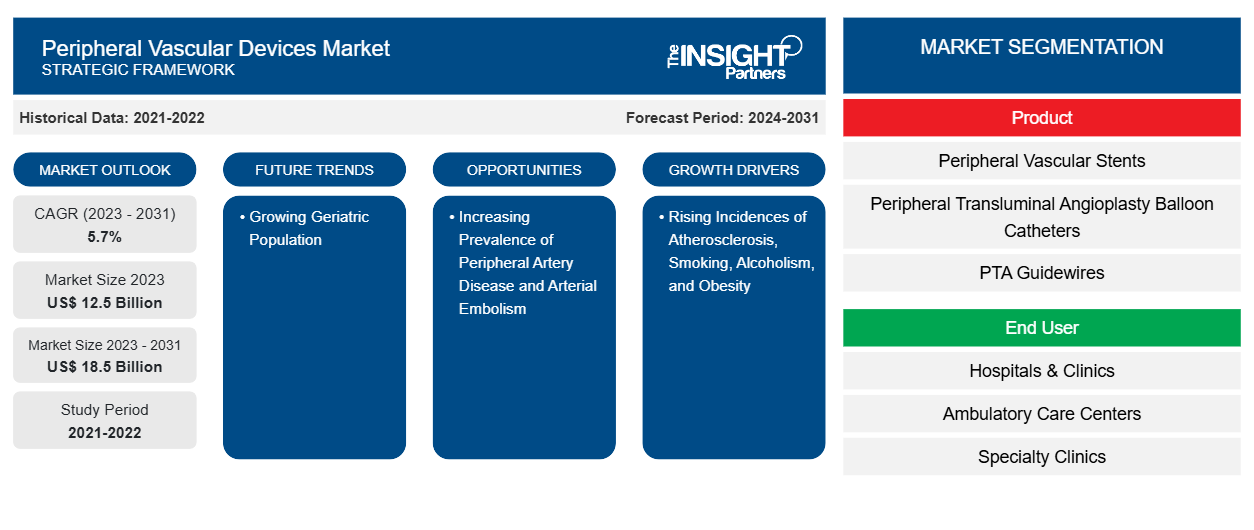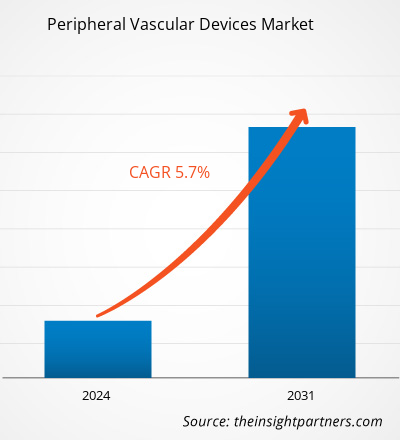The peripheral vascular devices market size is projected to reach US$ 18.5 billion by 2031 from US$ 12.5 billion in 2023. The market is expected to register a CAGR of 5.7% during 2023–2031. The drug eluting stents and balloons are likely to remain key trends in the market.
Peripheral Vascular Devices Market Analysis
Increasing prevalence of peripheral vascular diseases (PVD) is the key factor driving the market's growth. As per the WebMD, 8.5 million people in the United States have PVD. PVD is mostly observed in people aged 60 or more, affecting 12% - 20% of the population of that age group.
Peripheral Vascular Devices Market Overview
Increasing prevalence of peripheral vascular diseases (PVD), increase in conditions such as peripheral artery disease (PAD), deep vein thrombosis (DVT), and varicose veins, rising aging population, development of advanced devices such as bioresorbable vascular scaffolds, growing awareness for peripheral vascular devices, growing investments in healthcare infrastructure, favourable reimbursement policies are factors driving the growth of the peripheral vascular devices market.
Customize This Report To Suit Your Requirement
You will get customization on any report - free of charge - including parts of this report, or country-level analysis, Excel Data pack, as well as avail great offers and discounts for start-ups & universities
Peripheral Vascular Devices Market: Strategic Insights

-
Get Top Key Market Trends of this report.This FREE sample will include data analysis, ranging from market trends to estimates and forecasts.
Peripheral Vascular Devices Market Drivers and Opportunities
Rising Incidences of Smoking, Alcoholism, and Obesity
High prevalence of smoking, alcoholism, and obesity are contributing to increase in peripheral vascular diseases, thereby increasing the demand for peripheral vascular devices. As per the Centers for Disease Control and Prevention (CDC), in 2021, nearly 12 of every 100 US adults (11.5%) that is around 28.3 million adults in the US smoke cigarettes and over 16 million of them live with a smoking-related disease.
Growing Geriatric Population
Incidence and prevalence of peripheral disease increases with age. Thus, increase in elder population is likely to increase the demand for peripheral vascular devices market. As per the AARP International, Germany is one of the five “super-aged” societies in the world, and its population of people aged 65 and older will grow, reaching 24 million that is around one-third of its total population by 2050.
Peripheral Vascular Devices Market Report Segmentation Analysis
Key segments that contributed to the derivation of the peripheral vascular devices market analysis are product, and end user.
- The global peripheral vascular devices market, by product is segmented into peripheral vascular stents, PTA guidewires, peripheral transluminal angioplasty balloon catheters, atherectomy devices, aortic stents, chronic total occlusion devices, synthetic surgical grafts, and embolization guidewires. In 2023, the peripheral vascular stents segment held the largest share of the market, whereas, the peripheral transluminal angioplasty balloon catheters segment is expected to witness the fastest CAGR during the forecast period.
- In terms of end user, the market is categorised into hospitals and clinics, specialty clinics, ambulatory care centers, and others. In 2023, the hospitals and clinics segment held the largest share of the market and the same segment is also expected to witness fastest growth during the forecast period.
Peripheral Vascular Devices Market Share Analysis by Geography
The geographic scope of the peripheral vascular devices market report is mainly divided into five regions: North America, Asia Pacific, Europe, Middle East & Africa, and South & Central America.
The North America peripheral vascular devices market has been segmented into the US, Canada, and Mexico. Increased peripheral arterial disease, and rising demand for minimally invasive procedures are key factors driving the growth of the market in this region. Additionally, lifestyle changes, increase in aging population, and technological advancements are some of the prominent factors propelling the market growth in North America.
Europe holds a significant market share in the global peripheral vascular devices market. The growth of the market in the region is driven by increasing prevalence of peripheral arterial diseases, rise in the technological advancements, and rising government support.
Peripheral Vascular Devices Market Regional Insights
The regional trends and factors influencing the Peripheral Vascular Devices Market throughout the forecast period have been thoroughly explained by the analysts at The Insight Partners. This section also discusses Peripheral Vascular Devices Market segments and geography across North America, Europe, Asia Pacific, Middle East and Africa, and South and Central America.
Peripheral Vascular Devices Market Report Scope
| Report Attribute | Details |
|---|---|
| Market size in 2023 | US$ 12.5 Billion |
| Market Size by 2031 | US$ 18.5 Billion |
| Global CAGR (2023 - 2031) | 5.7% |
| Historical Data | 2021-2022 |
| Forecast period | 2024-2031 |
| Segments Covered |
By Product
|
| Regions and Countries Covered |
North America
|
| Market leaders and key company profiles |
|
Peripheral Vascular Devices Market Players Density: Understanding Its Impact on Business Dynamics
The Peripheral Vascular Devices Market is growing rapidly, driven by increasing end-user demand due to factors such as evolving consumer preferences, technological advancements, and greater awareness of the product's benefits. As demand rises, businesses are expanding their offerings, innovating to meet consumer needs, and capitalizing on emerging trends, which further fuels market growth.

- Get the Peripheral Vascular Devices Market top key players overview
Peripheral Vascular Devices Market News and Recent Developments
The peripheral vascular devices market is evaluated by gathering qualitative and quantitative data post primary and secondary research, which includes important corporate publications, association data, and databases. A few of the developments in the Veterinary Diagnostics market are listed below:
- Shockwave Medical, Inc., a pioneer in the development of Intravascular Lithotripsy (IVL) to treat severely calcified cardiovascular disease, announced the launch of the Shockwave L6 Peripheral IVL Catheter following clearance by the US Food and Drug Administration (FDA). (Source: Shockwave Medical, Press Release, March 2023)
- BD launches PAD treatment study with vascular-covered stent. (Source: BD, Newsletter, March 2024)
Peripheral Vascular Devices Market Report Coverage and Deliverables
The “Peripheral Vascular Devices Market Size and Forecast (2021–2031)” report provides a detailed analysis of the market covering below areas:
- Veterinary diagnostics market size and forecast at global, regional, and country levels for all the key market segments covered under the scope
- Veterinary diagnostics market trends as well as market dynamics such as drivers, restraints, and key opportunities
- Detailed PEST/Porter’s Five Forces and SWOT analysis
- Veterinary diagnostics market analysis covering key market trends, global and regional framework, major players, regulations, and recent market developments
- Industry landscape and competition analysis covering market concentration, heat map analysis, prominent players, and recent developments for the Veterinary Diagnostics market
- Detailed company profiles
Frequently Asked Questions
What is the expected CAGR of the peripheral vascular devices market?
What would be the estimated value of the peripheral vascular devices market by 2031?
Which are the leading players operating in the peripheral vascular devices market?
What are the future trends of the peripheral vascular devices market?
What are the driving factors impacting the peripheral vascular devices market?
Which region dominated the peripheral vascular devices market in 2023?
- Historical Analysis (2 Years), Base Year, Forecast (7 Years) with CAGR
- PEST and SWOT Analysis
- Market Size Value / Volume - Global, Regional, Country
- Industry and Competitive Landscape
- Excel Dataset
Recent Reports
Testimonials
Reason to Buy
- Informed Decision-Making
- Understanding Market Dynamics
- Competitive Analysis
- Identifying Emerging Markets
- Customer Insights
- Market Forecasts
- Risk Mitigation
- Boosting Operational Efficiency
- Strategic Planning
- Investment Justification
- Tracking Industry Innovations
- Aligning with Regulatory Trends





















 Get Free Sample For
Get Free Sample For